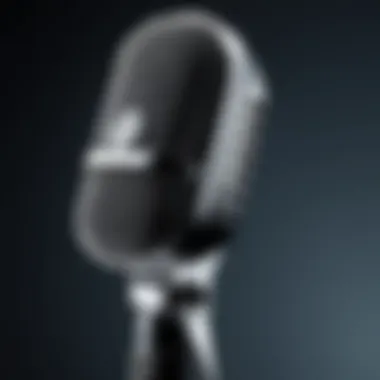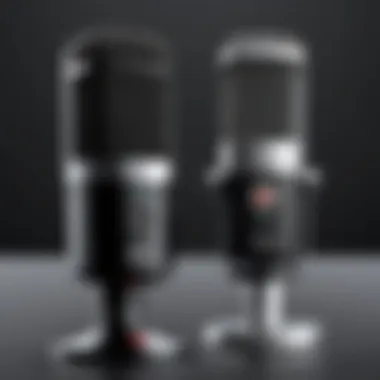Ultimate Guide to PC Microphones with Adjustable Arms


Intro
In recent years, PC microphones equipped with adjustable arms have gained prominence, transforming how we record audio. This shift reflects a growing appreciation for audio quality in various activities like streaming, podcasting, and professional content creation. The right microphone can significantly enhance sound clarity and ensure a pleasant listening experience for the audience.
As technology progresses, so do consumer expectations. Users now seek functionality alongside portability, making microphones with arms particularly appealing. They provide flexibility in positioning, which is key for achieving optimal sound capture. This article will explore the features, specifications, and overall performance of these microphones, aiding potential buyers in their decision-making process.
Product Overview
Key Features
Microphones with arms offer various features that cater to different user needs. Here are some critical attributes:
- Adjustable Arms: Allow precise positioning, reducing background noise and ensuring proper sound capture.
- Shock Mounts: Help isolate the microphone from vibrations and handling noise, enhancing audio clarity.
- Pop Filters: Minimize plosive sounds that may occur during speech, creating a cleaner audio output.
- Sound Quality: Many models provide high-definition audio, essential for professional applications.
Technical Specifications
Understanding technical specifications is crucial for evaluating a microphone's performance and compatibility. Typical specifications may include:
- Frequency Response: The range of sound frequencies the microphone can capture, usually expressed in Hertz.
- Sensitivity: A measure of how well a microphone converts sound into an electrical signal, typically expressed in dBV/Pa.
- Bit Depth and Sample Rate: Indicates audio fidelity; common settings include 16-bit/44.1kHz or 24-bit/96kHz.
Pricing Information
Prices for PC microphones with arms vary significantly based on features and brand. Entry-level models can cost around $50, while premium setups may exceed $300. Factors affecting pricing include brand reputation, material quality, and included accessories.
Performance Analysis
Benchmark Results
Testing various microphones reveals how they perform across different environments. Key metrics include:
- Noise Floor: Indicates how quietly the microphone operates. A lower noise floor is more desirable for clear recordings.
- Dynamic Range: A measurement of the difference between the softest and loudest sounds the microphone can capture effectively.
Real-World Use Cases
These microphones serve diverse purposes:
- Streaming: Clear audio is crucial for engaging audiences on platforms like Twitch.
- Podcasting: Requires reliable performance for extended periods.
- Voice-over Work: High fidelity helps in creating professional content.
Comparison with Competitors
When comparing various models, consider factors such as audio clarity, build quality, and additional features. Notable competitors might include Shure, Audio-Technica, and Rode, each offering unique attributes that appeal to different users.
Installation and Setup
Required Tools and Components
Setting up a microphone with an arm may require:
- A compatible audio interface or sound card
- USB or XLR cables, depending on the microphone type
- Mounting hardware or clamps for securing the arm
Step-by-Step Installation Guide
- Select a Suitable Location: Choose an area with minimal background noise.
- Attach the Arm Mount: Secure the arm to a desk or table.
- Connect the Microphone: Use the appropriate cable to connect the microphone to your computer or audio interface.
- Position the Microphone: Adjust the arm for optimal sound pickup.
- Test Audio Levels: Use audio software to ensure levels are set correctly.
Troubleshooting Common Issues
Common issues can include:
- Distorted audio: Check connections and gain settings.
- Background noise: Adjust positioning or consider using a pop filter.
Pros and Cons
Advantages of the Product
- Flexible positioning enhances sound quality.
- Improved ergonomics during long recording sessions.
- Versatility for various applications.


Disadvantages or Limitations
- Some models may be heavier and harder to adjust.
- Price can be a barrier for casual users looking for basic functionality.
Who It’s Best Suited For
These microphones are ideal for:
- Content creators seeking professional audio quality.
- Gamers who desire immersive sound experiences.
- Podcasters needing clarity and reliability in their recordings.
Final Thoughts
Summary of Key Points
Investing in a PC microphone with an adjustable arm can greatly affect audio quality. Understanding features, specifications, and potential uses is crucial for making an informed decision.
Recommendations for Potential Buyers
Before making a purchase, assess your specific needs and budget. Research user reviews and product comparisons to find the best fit.
Future of the Technology or Product Line
As technology continues to evolve, we can expect further enhancements in microphone design and functionality. This will likely pave the way for even more versatile and affordable options for consumers.
Prelims to PC Microphones
PC microphones have become essential tools for a wide range of applications that span from casual gaming to professional streaming. As technology evolves, the demand for high-quality audio has surged. Understanding PC microphones is key to unlocking their potential in enhancing communication and content creation. Users can make informed decisions by exploring features and specifications of microphones with adjustable arms, which offer a blend of functionality and practicality.
Defining PC Microphones
PC microphones are devices designed to capture audio signals and transmit them to a computer. They come in various forms, including condenser and dynamic microphones. Their primary function is to pick up sound and convert it into electronic signals, which then can be processed digitally. This function is crucial for applications like voice calls, video conferences, and multimedia productions.
Many factors characterize PC microphones, including type, pick-up pattern, and frequency response. The configuration and characteristics of each microphone may vary substantially. For example, some are optimized for close speaking, making them ideal for podcasters, while others can capture ambient sounds, better suited for music production.
Importance of Quality Audio
Quality audio cannot be overstated in today’s digital world. A clear and balanced sound significantly enhances the listener's experience. Whether it is a podcast, a gaming livestream, or a video conference call, superior audio quality plays a pivotal role in communication. Unlike visuals, listeners may not tolerate poor sound. They quickly lose interest if the audio is unclear or distorted.
Moreover, using a microphone with a good arm allows for flexible positioning. Proper positioning is essential for sound clarity. If a microphone is poorly placed, it can lead to unwanted noise or reduced sound quality. Thus, investing in a quality PC microphone not only improves voice capture but also enhances overall audio effectiveness.
In the realm of digital communication, audio fidelity can significantly influence engagement.
Understanding Microphone Arms
Microphone arms play a crucial role in the functionality and usability of PC microphones. They provide users the flexibility to adjust microphone positioning, ensuring optimal audio capture. This feature is highly relevant in various scenarios such as streaming, podcasting, and professional voice recording. A well-designed microphone arm can enhance both comfort and sound quality, ultimately improving the user experience.
What are Microphone Arms?
Microphone arms, also known as boom arms, are adjustable mounting systems designed to hold microphones securely. They typically feature multiple joints and pivot points, allowing for a wide range of motion. Most microphone arms can be anchored to desks or surfaces using clamps or mounts. This stability is essential for maintaining consistent audio quality, especially when vocalists or presenters move during their performance. The height and angle adjustments offered by microphone arms are significant for audio clarity and effective sound pickup.
Benefits of Adjustable Arms
Adjustable microphone arms come with numerous benefits that appeal to tech enthusiasts and casual users alike, including:
- Positioning Flexibility: Users can easily modify the microphone's position without the need for constant reinstallation. This ensures that the microphone captures sound in the best possible way, catering to each individual's needs.
- Space Efficiency: A well-designed arm minimizes desk clutter, as it can often be folded away when not in use. This aspect is particularly appealing for gamers and streamers who require an organized workspace.
- Improved Sound Isolation: By allowing the user to position the microphone closer to their mouth and away from noise sources, adjustable microphone arms contribute to enhanced sound isolation. This is especially beneficial in untreated rooms or noisy environments.
- Durability and Stability: High-quality microphone arms are built to withstand constant adjustments without losing stability. This ensures that the microphone remains firmly in place during use, preventing unwanted noise or disruptions during recording sessions.
In summary, understanding microphone arms is critical for making informed choices in selecting the right PC microphone setup. The adjustable nature of these arms directly influences user comfort, sound quality, and overall setup efficiency.
Technical Specifications of PC Microphones with Arms
Understanding the technical specifications of PC microphones with arms is crucial for anyone looking to enhance their audio experience. These specifications dictate the microphone's performance, making it essential to grasp their significance. Users must consider factors such as pick-up patterns, frequency response, and connectivity options before making a decision. Each of these elements contributes to the overall quality of sound capture and the usability of the microphone in various settings.
Pick-up Patterns Explained
Pick-up patterns determine how and from where a microphone captures sound. They define the area in which the microphone is most sensitive to sound waves. Common types of pick-up patterns include:
- Cardioid: This pattern captures sound primarily from the front, minimizing noise from the sides and rear. It is beneficial for solo recordings, streaming, and podcasting.
- Omnidirectional: These microphones pick up sound equally from all directions. This is useful in environments where multiple sound sources are present or for group discussions.
- Bidirectional: As the name suggests, these microphones record sound from the front and back, making them suited for interviews between two people.


Understanding these patterns helps users choose the right microphone for their specific needs and environments. For example, a cardioid microphone is often preferred in streaming, while an omnidirectional microphone is ideal for capturing ambient sounds.
Frequency Response and Sensitivity
Frequency response indicates the range of frequencies a microphone can capture effectively. This specification is measured in Hertz (Hz). A good microphone typically has a frequency response from around 20 Hz to 20 kHz, covering the human audible spectrum.
Sensitivity refers to how well a microphone converts acoustic energy into electrical signals. High sensitivity means the microphone can pick up quieter sounds, while low sensitivity means it requires louder sounds to produce a clear audio signal.
Considerations for frequency response will vary by application. For instance, vocals perform best in a range between 85 Hz and 255 Hz. A microphone suited for vocal recording should have enhanced sensitivity in this frequency range to ensure clarity and richness of sound.
Connectivity Options
Connectivity options play a significant role in compatibility with various devices. Common connectivity methods include:
- USB: Very popular among gamers and streamers due to ease of use. Simply plug it into the computer, and it's ready to go without additional drivers.
- XLR: While requiring an audio interface or mixer, XLR connections are ultra-reliable, used by professionals for higher audio quality.
- Wireless: Offers flexibility for movement but can introduce latency issues if not properly managed.
The choice of connectivity can affect the budget and setup complexity. Users should consider their existing equipment when selecting a microphone to ensure compatibility. Ultimately, understanding these options can enhance user experience and performance.
Proper knowledge of technical specifications will elevate your audio projects, whether for work or leisure.
Choosing the Right PC Microphone with Arm
Choosing the right PC microphone with an arm is crucial for various audio applications, including streaming, podcasting, and professional recording. The right setup can greatly influence the quality of the sound produced. With numerous models and features available, it can be challenging to select the most suitable option for individual needs. This section highlights specific elements, practical benefits, and essential considerations to simplify the decision-making process.
Identifying Your Needs
Before making a purchase, it is important to first identify your needs. Every user has unique requirements depending on how they plan to use the microphone. Here are some key factors to consider:
- Application Type: Determine if the microphone will be used for gaming, streaming, or recording podcasts. Each scenario has different demands. For example, a gamer may require superior voice clarity, while a podcaster might prioritize a microphone that captures a warm tone.
- Environment: Assess where the microphone will be located. If you work in a noisy setting, a microphone with a highly directional pick-up pattern can effectively minimize background noise.
- Portability: If you plan to move the microphone often, consider its weight and ease of setup. Some arms provide more flexibility for adjusting and are compact enough for travel.
By clearly defining these aspects, you can narrow down the choices effectively.
Budget Considerations
Budget plays a significant role in the decision-making process. Knowing how much to spend helps prevent overspending and limits options to a manageable selection. Here are a few points to guide your budget considerations:
- Determine Your Maximum Expenditure: Establish a budget range based on your financial situation. This makes the selection process easier as it filters out overly expensive models.
- Evaluate Features vs. Cost: Not all microphones are created equal. Higher-priced models often come with advanced features, but some affordable options may still meet your needs. Compare specifications carefully, such as frequency response and connectivity options, to assess value.
- Consider Long-Term Investment: Sometimes, spending slightly more on a quality microphone can be more prudent than opting for cheaper alternatives. A superior microphone may result in better performance and last longer, thus providing greater value over time.
Popular Models of PC Microphones with Arms
Understanding popular models of PC microphones with arms is crucial for anyone serious about audio quality. These models not only provide enhanced sound capture but also versatility in positioning, which is essential for various applications like streaming and podcasting. When exploring these options, it is vital to weigh factors such as audio performance, build quality, features, and price point.
Entry-Level Options
Entry-level microphones are ideal for beginners or those with a tight budget. They offer a balance of quality and price, making them accessible for new users. Some common characteristics include a decent frequency response and basic connectivity options.
Key Entry-Level Models:
- Blue Snowball: Known for its simplicity and great sound quality, this USB microphone fits well for podcasting and video calls. It is compact and user-friendly.
- Fifine K669B: This mic delivers good audio quality without breaking the bank. It is popular among streamers for its clear sound and sturdy build.
These models will suit casual users or those just starting their audio journey. They provide solid performance without requiring significant financial investment.
Mid-Range Recommendations
Mid-range microphones offer a considerable step up from entry-level options. These models typically feature better sound quality, additional settings, and improved build quality which contributes to a more professional experience. Users can benefit from enhanced audio clarity and more reliable connectivity.
Suggested Mid-Range Models:
- Audio-Technica AT2020: Renowned for its clear sound reproduction and durability. This microphone is highly versatile, making it perfect for recording vocals and instruments.
- Rode NT-USB: A USB microphone that boasts excellent sound quality and includes a pop filter. It is particularly well-suited for voiceover work and streaming.
In this category, users can expect great performance and professional-grade features without entering the high-end price range.
Professional Choices
For advanced users and professionals, high-end microphones provide outstanding sound fidelity and extensive features. These models often come with premium components and advanced functionalities, catering to specific recording needs and environments.
Top Professional Models:


- Shure SM7B: A dynamic microphone favored by professionals in various fields, including voice acting and music production. Its excellent sound isolation and quality make it a classic choice.
- Neumann TLM 102: Known for capturing nuanced audio details. This condenser microphone is highly regarded in studios and broadcasting settings due to its stellar performance.
Investing in professional microphones can lead to superior audio capturing capabilities, crucial for high-stakes environments.
The right microphone can significantly impact your audio quality. Select a model that aligns with your specific needs and budget.
In summary, selecting the correct PC microphone with an arm requires considering your needs, budget, and the quality of the models available. Each category offers products suitable for various users, from casual streamers to professional creators.
Setting Up Your PC Microphone and Arm
Setting up your PC microphone and arm is a pivotal process that can greatly impact your audio quality. An ideal setup can enhance sound clarity and reduce background noise, essential for streaming, podcasting, and any professional recording. Understanding the nuances of proper installation and positioning helps ensure that you get the most out of your equipment.
Installation Guidelines
When it comes to installing your PC microphone and arm, there are several essential steps to follow to achieve a successful setup. First, make sure to read the manufacturer’s instructions carefully, as each microphone model may have unique requirements.
- Choose the Right Location: Select a space that minimizes background noise. Ideally, find a room with carpets to absorb sound and few hard surfaces.
- Attach the Microphone to the Arm: Securely attach the microphone to the adjustable arm. Most arms have a clamping mechanism or threads that fit standard microphone mounts. Ensure it is tightly secured to avoid any sagging during use.
- Fix the Arm to Your Desk: The arm generally comes with a clamp that can be fixed to the edge of a desk. Make sure it is stable and won't slip when the microphone is adjusted.
- Connect to PC: Use the appropriate cable, such as USB or XLR, to connect your microphone to the PC. Confirm that the cable is securely plugged into both the microphone and the computer.
- Install Drivers/Software (if necessary): Some microphones may require additional drivers or software for optimal performance. Check the manufacturer’s website for any downloads needed.
By following these guidelines, you can ensure a solid foundation for all your audio activities, minimizing potential issues down the line.
Optimal Positioning Techniques
Positioning your microphone correctly is crucial in capturing high-quality audio. An improper setup can lead to unwanted sounds, echo, or distortion. Here are key techniques to consider:
- Distance from the Speaker: Ideally, the microphone should be positioned about six to twelve inches away from your mouth. This distance maintains clarity while reducing popping sounds from plosives.
- Angle of the Microphone: Aim the microphone towards your mouth at an angle rather than pointing it directly. This helps capture your voice more effectively while reducing sibilance.
- Use Pop Filters: If possible, employ a pop filter in front of the microphone. It helps to diffuse plosive sounds and improves overall sound quality.
- Adjust Arm Positioning: Ensure that the arm's reach allows for comfortable access without obstructing sightlines or movement. You should be able to easily adjust it during recording.
Proper positioning and placement play a huge role in audio fidelity. Take time to experiment with different setups until you find the perfect configuration.
By investing thought in installation and positioning, you set the stage for optimal performance and sound excellence. This effort can lead to significant improvements in audio quality, benefiting all listeners, whether for casual viewing or professional application.
Common Issues and Troubleshooting
In the realm of PC microphones with adjustable arms, understanding common issues and troubleshooting techniques is essential for users seeking optimal performance. Problems can arise that affect audio quality and the mechanical functionality of the arms. Addressing these concerns ensures a seamless user experience, especially for professionals who rely on quality sound during streaming, podcasting, or recording. It is prudent to recognize these issues early, as they can greatly influence overall satisfaction and effectiveness.
Audio Quality Problems
Audio quality is a critical concern for anyone utilizing a PC microphone. Poor audio can stem from several sources, including environmental noise, incorrect settings, or hardware malfunctions. It is vital to isolate these factors to enhance your audio recordings.
- Environmental Noise: Background sounds can distort audio. Ensure you are using soundproofing techniques, such as carpets or curtains, to reduce interference.
- Microphone Placement: The positioning of the microphone also matters. If placed too far away or at an improper angle, it can result in muffled audio.
- Settings Configuration: Regularly check your audio settings. Using the right bit rate and sample rate can prevent quality loss. Software applications often provide options to optimize audio settings, which can be beneficial for streamlining your recordings.
- Hardware Issues: Physical defects in the microphone can lead to subpar audio. If the microphone brand is known for reliability, yet you experience persistent problems, it may require replacement or professional repair.
Listening carefully to your audio during test recordings can provide valuable feedback to adjust your setup effectively.
Mechanical Issues with Arms
The mechanical arms that hold microphones can also present challenges. While they add convenience for positioning and adjustment, they are not immune to problems. Understanding these issues allows users to maintain their equipment effectively.
- Tension Problems: Adjustable arms may become too loose or too tight over time. Regularly check the tension and adjust it to ensure the microphone remains securely in place.
- Swivel Joints: Over time, the joints can become stiff or start to squeak, indicating the need for lubrication or maintenance. Failure to address this can lead to further deterioration or unexpected drops during use.
- Mounting Failures: Ensure that the arm is securely mounted to avoid accidents. Regular checks will prevent the microphone from falling and potentially breaking.
- Compatibility Issues: Sometimes, a microphone won’t fit properly with the arm. It is crucial to ensure that the microphone and arm are compatible. Checking specifications before purchase can save time and frustration.
In summary, being aware of and addressing common issues in audio quality and mechanical functionality can greatly enhance the performance of your PC microphone setup. Taking proactive measures will result in satisfactory performance, allowing users to enjoy their projects without disruption.
Culmination
In this article, we have explored the complex landscape of PC microphones with adjustable arms. Understanding these components is crucial for anyone wishing to elevate their audio experience. Quality audio is essential in various applications including streaming, podcasting, and professional recording.
Choosing the right microphone and arm setup can significantly affect the clarity and quality of sound produced. Factors like pick-up patterns, frequency response, and connectivity options play an indispensable role in this choice. In addition, knowing how to set up and position microphones correctly can prevent many common issues and improve overall performance.
"Investing in the right audio equipment is not just a purchase; it’s a long-term commitment to quality and clarity in sound."
Final Recommendations
For those in the market for a PC microphone with an arm, a few key considerations should guide your choice.
- Identify Your Needs: Determine the primary use of your microphone. Are you streaming, podcasting, or simply recording your voice for personal use? Each purpose may require different features.
- Budget Constraints: Establish a budget that reflects your requirements. There are viable options in every price range, but balance between price and quality is essential.
- Adjustability of the Arm: Make sure the microphone arm allows for flexibility in positioning. This will enhance your comfort and improve sound capture.
Brands like Blue Yeti, Audio-Technica, and Rode have proven models that cater to various needs while maintaining high audio quality.
The Future of PC Microphones
As technology evolves, the future of PC microphones looks promising. Trends indicate increased integration with smart technology, potentially enabling features like voice recognition and artificial intelligence to adjust settings automatically.
Moreover, wireless technology continues to improve, offering greater freedom without sacrificing audio fidelity. The rise in podcasting and streaming culture also pushes manufacturers to innovate, leading to better designs and functionalities. Notably, consumer feedback will play an essential role in shaping these developments.
In a world where audio quality increasingly matters, staying informed about advancements in PC microphones can significantly enhance your audio experience. With thoughtful consideration and planning, investing in the right equipment can yield benefits for years to come.



